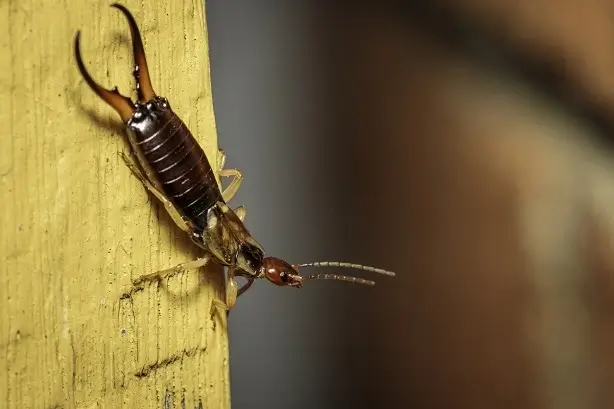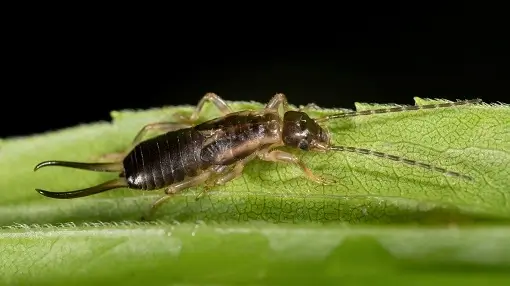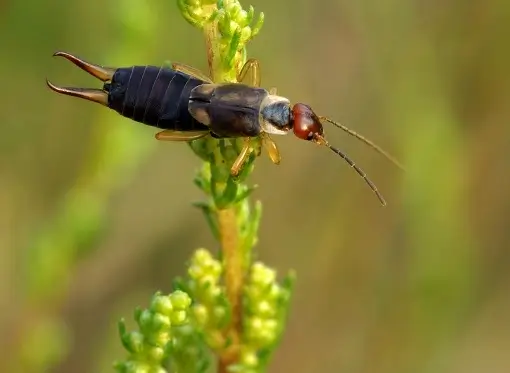
Earwigs
Earwig Control in Texas

Earwigs are pests outside the home because of the damage they can cause to ornamental and garden plants, and a nuisance when they enter homes seeking shelter and food. They are known to chew on living plant material including leaves, flowers, stems, fruits and roots. Garden plants commonly injured by earwigs in Texas include annual flowers; especially marigolds, dahlias and zinnias. They also prefer herbs, roses, berries, apricots, peaches, sweet corn tassels and silks.
Earwigs get their name from the (surprisingly popular) myth that their preferred nesting ground is in human ears. Stories have circulated since ancient times that earwigs love to burrow into our ears and lay their eggs. While it is true that earwigs like moist places, they’re no more likely to venture into a human ear than any other insect. The biggest problem that earwigs will present for your home is as a threat to your garden. That being said, it’s still not fun to see the little guys crawling around indoors.


Because their preferred habitat is damp wood, it’s smart to survey your home for drips and leaks. Check over undisturbed areas that are close to garbage or vegetation. Check your irrigation systems and rain gutters to make sure that moisture is being routed away from your home’s foundations.
In order to prevent earwigs in your home, we can evaluate the area and direct you to make changes that will keep them from getting in. Perimeter insecticides can deter earwigs from doors and windows and other entry points into your home.
Apply insecticides around the foundation, flower beds and turf within several yards of the home. In late spring to early summer, suppress earwig populations by targeting sites where they congregate, and on plants when injury appears. Place traps in the evening and collect and remove earwigs in the morning. Effective traps include shallow cans with vegetable or other odorous oils, moist rolled newspaper and cardboard boxes baited with oatmeal or bran. Be sure cardboard containers have pencil-sized holes near the bottom for entry.
While some DIY home treatments may take care of your earwig problem, the most effective solution is to call a licensed pest control company. Beeline Pest Control is at your service!
Questions that People Most Frequently Ask Us
Take a look at some of the typical questions that pop up in the minds of our clients
What type of damage do earwigs cause?
Earwigs can damage your home by eating the wood and leaves of your plants. They can also cause structural damage to your home if they infest it
How did earwigs get their name?
Earwigs got their name from an old wives’ tale that they would crawl into people’s ears and lay their eggs. However, this is not true. Earwigs are attracted to damp, dark places and can often be found in basements, crawl spaces, and other humid areas.
What purpose do earwigs serve?
Many people consider earwigs to be beneficial because they consume other insects, such as aphids. Earwigs, on the other hand, can harm plants and should be avoided if at all possible.
How do I know if I have an earwig infestation?
Some signs of an earwig infestation include finding earwigs in your home or business, seeing damage to your property, and hearing a hissing sound coming from earwigs
Where do earwigs live?
Earwigs are found all over the world. They are attracted to damp, dark places and can often be found in basements, crawl spaces, and other humid areas.
Will an earwig go into my ear?
No, earwigs will not go into your ear. They are attracted to damp, dark places and are often found in basements, crawl spaces, and other humid areas.
Can earwigs bite you?
No, earwigs cannot bite you. However, they may pinch you with their forceps-like jaws if you handle them. If you are pinched by an earwig, wash the area with soap and water to prevent infection.
Are earwigs good for my garden?
Some people believe that earwigs are good for gardens because they eat other insects, such as aphids. However, earwigs can also damage plants, so it is best to keep them out of your garden if possible.
Are earwigs harmful to humans or pets?
No, earwigs are not harmful to humans or pets. However, they can be a nuisance and may cause damage to your property if they infest it.
